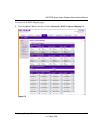
GS700TR Smart Switch Software Administration Manual
5-2 Configuring Quality of Service
v1.0, May, 2008
used to steer the packet to the appropriate outbound CoS queue through a mapping table. CoS
queue characteristics that affect queue mapping, such as minimum guaranteed bandwidth,
transmission rate shaping, etc., are user-configurable at the queue (or port) level.
Eight queues per port are supported.
The Class of Service folder contains links to the following features:
• “Basic CoS Configuration” on page 5-2
• “CoS Interface Configuration” on page 5-3
• “Interface Queue Configuration” on page 5-5
• “CoS Interface Configuration” on page 5-3
• “DSCP to Queue Mapping” on page 5-8
Basic CoS Configuration
Use the Trust Mode Configuration page to set the class of service trust mode of an interface. Each
port in the switch can be configured to trust one of the packet fields (802.1p or IP DSCP), or to not
trust any packet’s priority designation (untrusted mode). If the port is set to a trusted mode, it uses
a mapping table appropriate for the trusted field being used. This mapping table indicates the CoS
queue to which the packet should be forwarded on the appropriate egress port(s). Of course, the
trusted field must exist in the packet for the mapping table to be of any use, so there are default
actions performed when this is not the case. These actions involve directing the packet to a specific
CoS level configured for the ingress port as a whole, based on the existing port default priority as
mapped to a traffic class by the current 802.1p mapping table.
Alternatively, when a port is configured as untrusted, it does not trust any incoming packet priority
designation and uses the port default priority value instead. All packets arriving at the ingress of an
untrusted port are directed to a specific CoS queue on the appropriate egress port(s), in accordance
with the configured default priority of the ingress port. This process is also used for cases where a
trusted port mapping is unable to be honored, such as when a non-IP packet arrives at a port
configured to trust the IP DSCP value.
To display the Basic CoS Configuration page:
1. Click the QoS > Basic > CoS Configuration in the navigation tree.


















